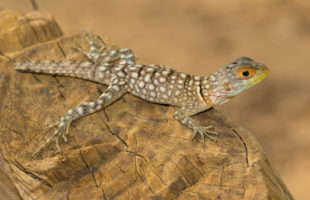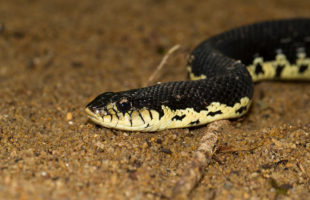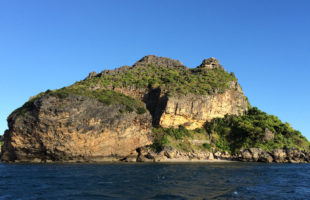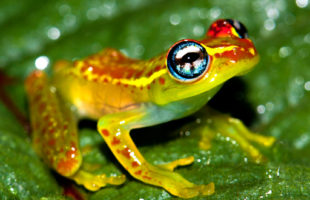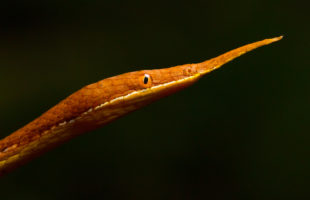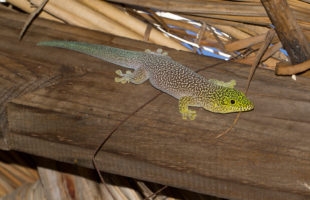Madagascar’s reptiles offer many a superlative. The smallest lizard in the world, the most colorful chameleons, the smallest iguana, the rarest tortoise – all that is missing is a record-breaking gecko. The Giant Leaf-tailed Gecko (Uroplatus giganteus) fills exactly this gap. It measures up to 34.5 cm and is thus the second largest gecko in the world. The giants among …
LesenSchlagwort-Archiv: Reptile
The Common Big-Eyed Snake
In Madagascar, no one needs to be afraid of snakes. One of the most common snakes in the west and south of the island is the Common Big-Eyed Snake (Mimophis mahfalensis). But it is also one of the most harmless snakes that only bite in the worst of times. If you simply watch it, you will discover exciting behaviours. The …
LesenCuvier’s Madagascar Swift: Oplurus cuvieri
It actually isn’t really big, but at least clearly the biggest in its family: The big Cuvier’s Madagascar Swift (Oplurus cuvieri) measures a maximum of 38 cm from the nose to the tip of the tail. Alone the scaly tail constitutes good 20 cm of it. Cuvier’s Madagascar Swift belongs to the family of the Madagascar iguana, that there is …
LesenAmber mountain national park
Amber Mountain: The name comes from the flowers of certain trees that cover the mountain and shine amber from afar. Location: The Amber Mountain National Park is located in northwestern Madagascar in the Diana region. The nearest major city is Antsiranana (Diego Suarez) on the coast, about 30 km away. From the capital Antananarivo, the park is located about 1000 …
LesenMadagascar’s giant hognose snake
The Madagascar giant hognose snake (Leioheterodon madagascariensis) probably belongs to Madagascar’s most common snakes. You can meet them almost everywhere on the island: Rainforests of the east coast are part of its home range as well as the hot and dry west oft Madagascar. They can even deal with widely devastated forests. Gardens, campgrounds and hut villages may also be …
LesenNosy Hara national park
Nosy Hara: The name means “mountainous island” (hara comes from the Malagasy harana = mountains), which goes back to the characteristic needle stone rock formations. The island belongs to a small archipelago of twelve uninhabited islands surrounded by coral reefs. Location: The island of Nosy Hara is located in northern Madagascar in the Baie de Courrier, which belongs to the …
LesenThe second smallest reptile on Earth
It can sit on a matchstick without a problem, and you could almost think that the slightest breeze will blow the fragile pipsqueak off the match: Brookesia micra, the second smallest* reptile on Earth. Despite its few millimeters body lengths, the little, brown leaf chameleon has everything other chameleons need for life, too: Eyes moving to every possible direction, a …
LesenMitsinjo reserve
Mitsinjo: Mitsinjo means as much as “looking ahead” or “planning the future”. Location: The reserve is located close to the village Andasibe in eastern Madagascar, around 140 km away from the capital Antananarivo, in the region Alaotra-Mangoro. You drive approximately four hours on RN2, which is not in the best condition, and then change direction at a well-signed junction. Information …
LesenThe Malagasy leaf-nosed snake
A nose that somehow resembles a frayed leaf and can be bent, and an elongated body: these are the most outstanding characteristics of the Langaha madagascariensis, one of many bizarre animals in Madagascar. The purpose of the bizarre nasal process has not yet been clarified. In males, it looks more like a Pinocchio nose than a leaf. The name of …
LesenA gecko jewel: Standing’s Day Gecko
In southwest Madagascar, between spiny forests and wooden huts, lives a gecko with triking colours: Standing’s Day Gecko (Phelsuma standingi). Who visits the dry, hot area between Morombe, Toliara (French Tuléar) and the national park Isalo, will sooner or later meet this beautiful reptile. It originally lives in dry and spiny forests, but today – contrary to many other, outdated …
Lesen MADAMAGAZINE Your Magazine about Madagascar
MADAMAGAZINE Your Magazine about Madagascar



